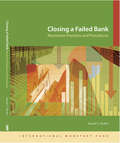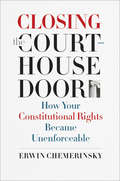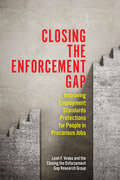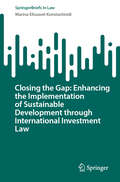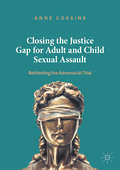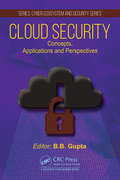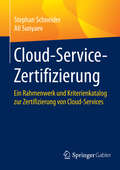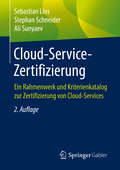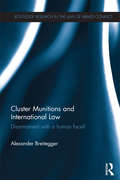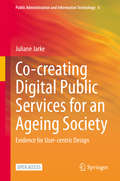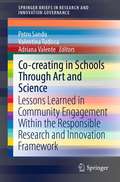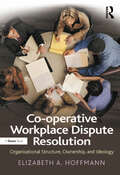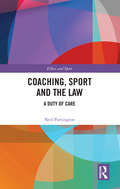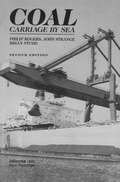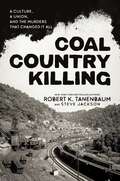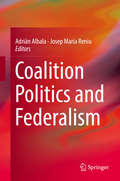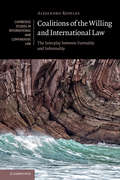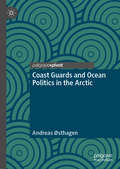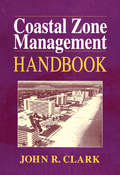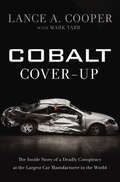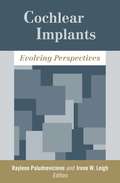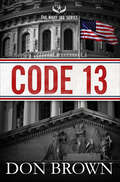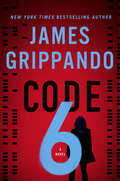- Table View
- List View
Closing the Courthouse Door: How Your Constitutional Rights Became Unenforceable
by Erwin ChemerinskyA leading legal scholar explores how the constitutional right to seek justice has been restricted by the Supreme Court The Supreme Court's decisions on constitutional rights are well known and much talked about. But individuals who want to defend those rights need something else as well: access to courts that can rule on their complaints. And on matters of access, the Court's record over the past generation has been almost uniformly hostile to the enforcement of individual citizens' constitutional rights. The Court has restricted who has standing to sue, expanded the immunity of governments and government workers, limited the kinds of cases the federal courts can hear, and restricted the right of habeas corpus. Closing the Courthouse Door, by the distinguished legal scholar Erwin Chemerinsky, is the first book to show the effect of these decisions: taken together, they add up to a growing limitation on citizens' ability to defend their rights under the Constitution. Using many stories of people whose rights have been trampled yet who had no legal recourse, Chemerinsky argues that enforcing the Constitution should be the federal courts' primary purpose, and they should not be barred from considering any constitutional question.
Closing the Enforcement Gap: Improving Employment Standards Protections for People in Precarious Jobs (Studies in Comparative Political Economy and Public Policy)
by Leah Faith VoskoThe nature of employment is changing: low wage jobs are increasingly common, fewer workers belong to unions, and workplaces are being transformed through the growth of contracting-out, franchising, and extended supply chains. Closing the Enforcement Gap offers a comprehensive analysis of the enforcement of employment standards in Ontario. Adopting mixed methods, this work includes qualitative research involving in-depth interviews with workers, community advocates, and enforcement officials; extensive archival research excavating decades of ministerial records; and analysis of a previously untapped source of administrative data collected by Ontario’s Ministry of Labour. The authors reveal and trace the roots of a deepening "enforcement gap" that pervades nearly all aspects of the regime, demonstrating that the province’s Employment Standards Act (ESA) fails too many workers who rely on the floor of minimum conditions it was devised to provide. Arguably, there is nothing inevitable about the enforcement gap in Ontario or for that matter elsewhere. Through contributions from leading employment standards enforcement scholars in the US, the UK, and Australia, as well as Quebec, Closing the Enforcement Gap surveys innovative enforcement models that are emerging in a variety of jurisdictions and sets out a bold vision for strengthening employment standards enforcement. Closing the Enforcement Gap Research Group Leah F. VoskoGuliz AkkaymakRebecca CaseyShelley CondrattoJohn GrundyAlan HallAlice HoeKiran MirchandaniAndrea M. NoackUrvashi Soni-SinhaMercedes SteedmanMark P. ThomasEric M. Tucker International/Quebec ContributorsNick ClarkDalia Gesualdi-FecteauTess HardyJohn HoweGuylaine ValléeDavid Weil
Closing the Gap: Enhancing the Implementation of Sustainable Development through International Investment Law (SpringerBriefs in Law)
by Marina-Elissavet KonstantinidiThis book examines the applicability of the United Nations' Sustainable Development Goals within the framework of International Investment Law, assessing its effectiveness and identifying areas in need for reform. It aims to contribute to a strategic approach for sustainable development in the era of globalization, addressing pressing social concerns. More specifically, this book explores if and how the tools offered by international investment law can be utilized to advance the principles of sustainable development. The study further investigates how the notion of sustainable development affects the arguments regarding the existence of a protected investment, and potential violations of investment treaty clauses concerning, namely, the fair and equitable treatment standard, illegal expropriation and umbrella clauses. It aims to provide suggestions for reform, focusing on the creation of preventive mechanisms, in addition to existing repressive ones. The above-mentioned issues have direct influence on key areas of public interest, such as environmental protection and public health, which ar integral to sustainable development. It is crucial to ensure that investment protection does not come at the expense of the above, and international investment law can rather be used as a tool for positive change at a global scale. It is, therefore, of utmost importance to identify existing conflicts in the field and raise concerns, in order to achieve a balance of interests between States and investors, and take a step closer to the realization of the UN Sustainable Development Goals.
Closing the Justice Gap for Adult and Child Sexual Assault: Rethinking the Adversarial Trial
by Anne CossinsThis book examines the justice gap and trial process for sexual assault against both adults and children in two jurisdictions: England and Wales and New South Wales, Australia. Drawing on decades of research, it investigates the reality of the policing and prosecution of sexual assault offences – often seen as one of the ‘hardest crimes to prosecute’ – across two similar jurisdictions. Despite the introduction of the many reform options detailed in the book, satisfactory outcomes for victims and the public are still difficult to obtain.Cossins takes a new approach by examining the nature and effects of adversarialism on vulnerable witnesses, jury decision-making and the structures of power within the trial process, to show how, and at what points, that process is weighted against complainants of sexual assault, in order to make evidence-based suggestions for reform. She argues that this justice gap is a result of a moralistic adversarial culture which fosters myths and misconceptions about rape and child sexual assault, thus requiring the prosecution to prove a complainant’s moral worthiness. She argues this culture can only be eliminated by a radical replacement of the adversarial system with a trauma-informed system. By reviewing the relevant psychological literature, this book documents the triggers for re-traumatisation within an adversarial trial, and discusses the reform measures that would be necessary to transform the sexual assault trial from one where the complainant’s moral worthiness is ‘on trial’ to a fully functioning trauma-informed system. It speaks to students and academics across subjects including law, criminology, gender studies and psychology, and practitioners in law and victim services, as well as policy-makers.
Closure
by John Lescroart M. J. RoseFrom two bestselling masters of suspense, a gripping, erotic story about a female assassin whose unsettling past comes back to haunt her...Beautiful twenty-something Lucy Delray has spent two months in therapy when she says to her psychologist, "When I destroy someone...I don't feel anything." An avenging angel who lures men into her bed and then kills them, she qualifies this shocking confession: "I only kill men who deserve it. Who have done the unforgivable. Who need to be punished." But when Lucy lures an influential man from her childhood back into her life--a painter she befriended when she was only seven years old--the charming temptress may be committing the ultimate crime: letting a long-buried secret interfere with the job at hand...
Cloud Computing for Lawyers
by Nicole Black Richard SusskindAs more businesses move their IT systems into the cloud, lawyers need to ask if cloud computing is right for their firm. Cloud Computing for Lawyers features a discussion of cloud computing fundamentals, an overview of legal cloud computing products, and step-by-step instructions for implementing cloud computing in your practice--including practical tips for securing your data.
Cloud Security: Concepts, Applications and Perspectives (Cyber Ecosystem and Security)
by Brij B GuptaCloud computing is an indispensable part of the modern Information and Communication Technology (ICT) systems. Cloud computing services have proven to be of significant importance, and promote quickly deployable and scalable IT solutions with reduced infrastructure costs. However, utilization of cloud also raises concerns such as security, privacy, latency, and governance, that keep it from turning into the predominant option for critical frameworks. As such, there is an urgent need to identify these concerns and to address them.Cloud Security: Concepts, Applications and Perspectives is a comprehensive work with substantial technical details for introducing the state-of-the-art research and development on various approaches for security and privacy of cloud services; novel attacks on cloud services; cloud forensics; novel defenses for cloud service attacks; and cloud security analysis. It discusses the present techniques and methodologies, and provides a wide range of examples and illustrations to effectively show the concepts, applications, and perspectives of security in cloud computing. This highly informative book will prepare readers to exercise better protection by understanding the motivation of attackers and to deal with them to mitigate the situation. In addition, it covers future research directions in the domain. This book is suitable for professionals in the field, researchers, students who are want to carry out research in the field of computer and cloud security, faculty members across universities, and software developers engaged in software development in the field.
Cloud-Service-Zertifizierung: Ein Rahmenwerk und Kriterienkatalog zur Zertifizierung von Cloud-Services
by Stephan Schneider Ali SunyaevDie Auslagerung von Services in die Cloud ist mit Risiken verbunden. Dieses Buch liefert ein Rahmenwerk zur Zertifizierung von Services in der Cloud. Herzstück dabei ist ein umfangreicher Kriterienkatalog zum Assessment von Cloud-Services. Dabei wendet sich das Buch an Cloud-Service-Anwender und unterstützt bei der Bewertung, dem Vergleich und der Auswahl von Angeboten. Gerade in kritischen Bereichen wie Sicherheit, Verfügbarkeit und Vertragsfragen unterstützt der Katalog bei der Definition von eigenen Anforderungen. Das Buch eignet sich jedoch auch für Cloud-Service-Anbieter, die es zum Self-Assessment und zur Verbesserung der eigenen Services nutzen können. Das Buch fasst eines der Ergebnisse des dreijährigen Forschungsprojekts ,,Value4Cloud" zusammen, das im Rahmen des Technologieprogramms ,,Trusted Cloud" vom Bundesministerium für Wirtschaft und Technologie gefördert wurde. Es liefert mit 219 Zertifizierungskriterien und einem Zertifizierungsrahmenwerk einen wichtigen Beitrag zum Assessment von Cloud-Services und der Verbesserung von Cloud-Service-Zertifizierungen.
Cloud-Service-Zertifizierung: Ein Rahmenwerk und Kriterienkatalog zur Zertifizierung von Cloud-Services
by Stephan Schneider Ali Sunyaev Sebastian LinsDieses Buch liefert ein Rahmenwerk zur Zertifizierung von Services in der Cloud. Herzstück dabei ist ein umfangreicher Kriterienkatalog zum Assessment von Cloud-Services, der im Forschungsprojekt „Value4Cloud“ , gefördert vom Bundesministerium für Wirtschaft und Technologie, entwickelt wurde. Cloud-Service-Anwender werden bei der Bewertung, dem Vergleich und der Auswahl von Services unterstützt. Das Buch eignet sich auch für Cloud-Service-Anbieter zum Self-Assessment und zur Verbesserung der eigenen Services.
Cluster Munitions and International Law: Disarmament With a Human Face? (Routledge Research in the Law of Armed Conflict)
by Alexander BreiteggerThis book offers a comprehensive argument for why pre-existing international law on cluster munitions was inadequate to deal with the full scope of humanitarian consequences associated with their use. The book undertakes an interdisciplinary legal analysis of restraints and prohibitions on the use of cluster munitions under international humanitarian law, human rights law, and international criminal law, as well as in relation to the recently adopted Convention on Cluster Munitions (CCM). The book goes on to offer an in-depth substantive and procedural analysis of the negotiations which led to the 2008 CCM, in part based on the author’s experiences as an adviser to Cluster Munitions Coalition-Austria. Cluster Munitions and International Law is essential reading for practitioners and scholars of International Law, including International Humanitarian, Human Rights, International Criminal or Disarmament Law and anyone interested in legal and humanitarian perspectives on cluster munitions legislation and policy. It is unique in bringing a practitioner’s perspective to a scholarly work.
Co-creating Digital Public Services for an Ageing Society: Evidence for User-centric Design (Public Administration and Information Technology #6)
by Juliane JarkeThis open access book attends to the co-creation of digital public services for ageing societies. Increasingly public services are provided in digital form; their uptake however remains well below expectations. In particular, amongst older adults the need for public services is high, while at the same time the uptake of digital services is lower than the population average. One of the reasons is that many digital public services (or e-services) do not respond well to the life worlds, use contexts and use practices of its target audiences. This book argues that when older adults are involved in the process of identifying, conceptualising, and designing digital public services, these services become more relevant and meaningful.The book describes and compares three co-creation projects that were conducted in two European cities, Bremen and Zaragoza, as part of a larger EU-funded innovation project. The first part of the book traces the origins of co-creation to three distinct domains, in which co-creation has become an equally important approach with different understandings of what it is and entails: (1) the co-production of public services, (2) the co-design of information systems and (3) the civic use of open data. The second part of the book analyses how decisions about a co-creation project’s governance structure, its scope of action, its choice of methods, its alignment with strategic policies and its embedding in existing public information infrastructures impact on the process and its results. The final part of the book identifies key challenges to co-creation and provides a more general assessment of what co-creation may achieve, where the most promising areas of application may be and where it probably does not match with the contingent requirements of digital public services. Contributing to current discourses on digital citizenship in ageing societies and user-centric design, this book is useful for researchers and practitioners interested in co-creation, public sector innovation, open government, ageing and digital technologies, citizen engagement and civic participation in socio-technical innovation.
Co-creating in Schools Through Art and Science: Lessons Learned in Community Engagement Within the Responsible Research and Innovation Framework (SpringerBriefs in Research and Innovation Governance)
by Adriana Valente Valentina Tudisca Petru SanduThis book represents an applied, up-to-date work on RRI developments and their potential positive impact on societies. The societal challenges of the 21st century require the ability to integrate the knowledge and expertise of different societal actors, using more innovative, efficient and open approaches. Educational methodologies are in perpetual development in their attempt to provide tentative answers to three ever-changing digital age challenges: the challenge of speed, the challenge of form/at and the challenge of persistency. The current book aims to address these issues by presenting relevant case studies in the field of art, science and giving value to territory that, by the means of projects and initiatives using RRI consistent methodologies, have succeeded in their attempt to: preserve and valorise cultural heritage by using digital storytelling or crowddreaming methodology, develop educational strategies grounded on RRI and Open Schooling principles, contribute to new ways of thinking in the school environment by using RRI and promote gender equality and stimulate critical reflections on women’s role in science by the means of storytelling and RRI concepts.
Co-operative Workplace Dispute Resolution: Organizational Structure, Ownership, and Ideology
by Elizabeth A. HoffmannUnderstanding the complex dynamics involved in workplace disputes helps improve the way organizations deal with unwelcome but inevitable occurrences. These issues have been researched from different perspectives, but previously such research has failed to ask how flattened organizational form might impact ways of resolving disputes, focusing instead on what occurs in conventional, hierarchical organizations only. In Co-operative Workplace Dispute Resolution, Elizabeth Hoffmann considers the question of how workplace disputes are raised in the absence of formal hierarchy. In contrast to conventionally organized businesses, co-operatives attempt to evenly distribute power and ownership and encourage worker control through egalitarian ideologies, flattened management structures and greater information sharing. Like conventional businesses, though, they still pursue goals relating to profit and efficiency. Dr Hoffmann argues that lessening hierarchy and sharing power, as occurs in co-operatives, provides insight into how greater worker involvement and ownership might operate in a less extreme and more modest form in conventional mainstream business. This book focuses on dispute resolution strategies at matched pairs of worker co-operatives and conventional businesses in three very different industries: coal mining, taxicab driving, and wholefood distribution. The author’s central finding is that the worker co-operative members have access to more dispute resolution strategies than their conventionally employed counterparts. This leads to the conclusion that benefits might be achieved by conventional businesses that wish to embrace specific attributes usually associated with co-operatives, including management-employee cooperation, shared ownership, or greater workplace equality.
Coaching, Sport and the Law: A Duty of Care (Ethics and Sport)
by Neil PartingtonThe interdependent coach-athlete relationship represents the most fundamental instance of a duty of care in sport. This book defines, analyses and clarifies the duty of care incumbent upon sports coaches and identifies important recommendations of real-world significance for coaching practice. Given the dynamic relationship between coaching, sport and the law, it is imperative that coaches have an informed awareness of the evolving legal context in which they discharge their duty of care. Detailed analysis of a coach’s duty of care has so far been lacking. The book addresses this gap by being the first to critically scrutinise the concept of duty of care in the specific context of sports coaching. Sustained analysis of the developing case law allows the scope and boundaries of the particular duties demanded of coaches to be rigorously examined. The legal principles and court decisions discussed relate to coaching delivered in a wide range of individual and team sports, at both amateur and professional levels of performance, and include common scenarios and challenges frequently encountered by sports coaches globally. By adopting an interdisciplinary approach within a broader sociolegal methodological framework, this book’s detailed analysis and original insights will prove highly instructive for practising coaches, coach educators, and national governing bodies of sport. It also offers extremely valuable insights for students, teachers and practitioners involved in sports law, sports coaching, sports ethics, tort law, sports policy and development, sports studies and physical education.
Coal Carriage by Sea
by John Strange Phil Rogers Brian StuddPart of the ""Carriage by Sea"" series, this second edition contains statistical information on coal consumption, production and trade, including comparative statistics by geographical area, together with full analysis. The carriage of coal by sea, including the specifications and problems of vessels used to carry coal, terminal operations and charterparties are also covered, as are some of the most frequently arising claims and preventative measures. The book is suitable for companies involved in the coal trades, including shipowners, operators, charterers, managers, shipbuilders and coal exporters and importers.
Coal Country Killing: A Culture, A Union, and the Murders That Changed It All
by Robert K. Tanenbaum Steve JacksonA triumphant, uplifting true justice story led by jury trial expert, Richard A. Sprague—the indomitable, nationally renowned prosecutor who engaged in the most intense manhunt investigation in police history.Coal Country Killing: A Culture, A Union, And The Murders That Changed It All, revolves around the cold-blooded 1969 assassination of United Mineworkers of America &“reform candidate&” Jock Yablonski, and murder of his wife and daughter in their Pennsylvania farmhouse. But driving the story are the extraordinary efforts of a tenacious special prosecutor and his &“army&” of investigators to bring the gunmen, the union boss who ordered the murders, and his henchmen who saw them carried out, to justice. Initially, three bumbling small-time criminals, dubbed &“The Hillbilly Hitmen,&” were arrested and charged. But they were the tip of the iceberg as the murders were directed by then-UMWA President &“Tough Tony&” Boyle as revenge for Yablonski running against him in the bitterly contested 1968 union election and to prevent his corruption from being exposed. Up against the tight-lipped culture of Appalachia coal country, legendary Philadelphia homicide prosecutor Richard A. Sprague, and his investigators, spent nearly nine years doggedly working their way up the ladder of those responsible to the final showdown with Boyle. Written by New York Times bestselling authors—former New York County Assistant District Attorney Robert K. Tanenbaum, a lifelong friend of Sprague&’s, and Steve Jackson—Coal Country Killing is a tour de force for those who love justice.
Coalition Politics and Federalism
by Adrián Albala Josep Maria ReniuThis book analyzes the verticalization of coalition cabinets from the national to the sub-national level. Presenting case studies for countries with federal systems of government, such as Argentina, Australia, Brazil, Canada, Germany, and India, as well as those focusing on states with hybrid systems of government, such as Italy, the contributors analyze multilevel government formation processes to identify vertical congruence between national and sub-national coalitions. The book also examines various factors affecting the degree of congruence of political coalitions, such as the degree of decentralization, federalization and institutionalization of political systems, as well as cleavage structure. This book will be a valuable resource for all scholars interested in coalition politics, as well as for politicians and practitioners in government and parliament.
Coalitions of the Willing and International Law: The Interplay between Formality and Informality (Cambridge Studies in International and Comparative Law #135)
by Alejandro RodilesGlobal action and regulation is increasingly the result of the interplay between formality and informality. From the management of State conduct in international security to the coordination of national policies in climate change, international organizations work ever closer with coalitions of the willing. This book carefully describes this dynamic game, showing that it consists of transformative orchestration strategies and quasi-formalization processes. On the institutional plane, coalitions of the willing turn into 'durable efforts', while international organizations perform as 'platforms' within broader regime complexes. On the normative level, informal standards are framed in legal language and bestowed with the force of law, while legal norms are attached to multilayered schemes of implementation, characterized by pragmatic correspondences, persuasion tactics, and conceptual framing. Understanding how this interplay alters the notion of 'international legality' is crucial for the necessary recalibrations of the political ideals that will inform the rule of law in global governance.
Coast Guards and Ocean Politics in the Arctic
by Andreas ØsthagenThis book is about how coast guards are becoming states’ foremost tool to manage changes occurring in ocean politics generally, and in the Arctic specifically. It looks at states’ rights at sea, changes occurring in the Arctic region, how coast guards are handling issues arising, and how international cooperation can deal with some of the related challenges.
Coastal Zone Management Handbook
by John R. ClarkCoastal Zone Management Handbook comprises the first complete manual on coastal resource planning and management technology. Written by an international consultant, this handbook reflects a global perspective on the natural resources, sensitivities, economics, development, productivity, and diversity of coastal zones. The emphasis is on tropical and subtropical coastal ecosystems, but the information is widely applicable. In addition to its comprehensive coverage of general concepts related to coastal regions, the book describes the strategic basis for coastal management, provides a set of working tools for management and planning activities, and presents case histories of management projects around the globe. Extensive references are provided for each management analysis, practice, technique, and solution. Coastal Zone Management Handbook is made up of four sections:
Cobalt Cover-Up: The Inside Story of a Deadly Conspiracy at the Largest Car Manufacturer in the World
by Mark Tabb Lance A. CooperFollowing a deadly car crash, small-town lawyer Lance Cooper risked everything to battle one of the most powerful auto corporations in the world to get justice for a young woman. A fast-paced, journalistic account of tragedy turned to triumph, despair to hope, Cobalt Cover-Up is an inspirational, thoroughly compelling, and victorious read. In the midst of his own family struggles, small-town Georgia lawyer Lance Cooper agreed to defend Ken and Beth Melton and investigate the deadly accident that killed their daughter Brooke after she inexplicably lost control of her Chevy Cobalt. But what started as a heartbreaking yet all too common lawsuit quickly escalated into a David vs. Goliath case when Cooper discovered shocking evidence that General Motors concealed an ignition switch defect for nearly a decade--resulting in 124 deaths, including Brooke's, and risking the lives of millions more. Despite GM's settlement offers and attempts to bury evidence, Cooper refused to back down and worked tirelessly to expose the truth. Locked in a tenacious legal fight, Cooper and the Meltons faced incredible odds--Ken and Beth losing jobs and suffering the difficulty of grieving a beloved daughter during a court battle, Cooper risking his reputation and private practice against the overwhelming opposition from GM's team of lawyers, and both parties facing massive financial strain. Yet, in the relentless pursuit for justice and to protect future innocent lives, this small-town lawyer and a working-class American couple stared down the biggest US auto manufacturing mogul and ultimately transformed the entire industry.
Cochlear Implants: Evolving Perspectives
by Raylene Paludneviciene Irene W. LeighThe cochlear implant debate has changed, as evidenced in this cogent collection that presents 13 chapters by 20 experts, including several who communicate through sign language but also utilize cochlear implants. The impetus for this change stems from recognition that both visual and aural input can enhance the education of deaf children. Divided into four sections, Cochlear Implants: Evolving Perspectives first focuses on the impact of implants in the Deaf community. Chapters in this section examine the issues driving the cochlear implant debate, the ethics of genetic engineering, experiences of implanted adult deaf signers, reflections of deaf mothers who have had their children implanted, and the effects of implants on deaf identity. The second section delves into the mechanics of bimodal processing, including listening strategies that can benefit signing children with cochlear implants. The third section surveys combined aural/visual educational approaches, such as teaching implanted children in an ASL/English bilingual classroom, and applying auditory rehabilitation to a signed communication context. The final section challenges readers to reframe the debate first by exploring sensory politics, then by envisioning an emerging world that requires the Deaf community to connect with it to secure its future. With this information, readers will reach their own conclusions about cochlear implants and auditory and visual approaches to the mastery of both spoken and signed languages.
Code 13 (The Navy JAG Series #2)
by Don BrownTHE U.S. NAVY&’S BILLION-DOLLAR CONTRACT FOR THE SALE OF DRONES LANDS TWO NAVY JAG OFFICERS IN THE GUN SIGHTS OF A KILLER.Caroline is just getting her feet wet at the prestigious Code 13, but is thankful for at least one familiar face—her old flame, P.J. MacDonald. He loops her into the assignment he is currently working on—the legality of a proposed drone-sharing contract with Homeland Security that would allow the sale of drones for domestic surveillance. The contractor wants a legal opinion clearing the contract for congressional approval. But the mob wants the proposal dead-on-arrival.When P.J. is gunned down in cold blood and a second JAG officer is killed, one thing becomes clear: whoever is ordered to write the legal opinion on the drones becomes a target. Which is exactly why Caroline goes to her commanding officer and volunteers to write the legal opinion herself. She is determined to avenge P.J.&’s death and trap the killer, even if that means making herself a target.It is a deadly game of Russian roulette for the sake of justice, but Caroline is determined to see it through, even if it costs her life.
Code 6: A Novel
by James Grippando“A Pandora’s box of demons. . . . High-stakes espionage, family drama, double crosses, noble gestures . . . it’s all here.” — Kirkus Reviews“An ambitious thriller that. . . delivers a deeply satisfying conclusion. . . . Code 6 features some of Grippando's most compelling characters and one of his most intriguing stories.” — BooklistHarper Lee Prize winner and New York Times bestselling author James Grippando returns with a bold new thriller that asks at what price do we open our lives to Big Data.Aspiring playwright, Kate Gamble, is struggling to launch a script she’s been secretly researching her entire life, mostly at the family dinner table. Her father is Christian Gamble, CEO of Buck Technologies, a private data integration company whose clients include the CIA and virtually every counter-terrorism organization in the Western World. Kate’s father adores her, and a play about the dark side of Big Data would be the ultimate betrayal in his eyes. But Kate is compelled to tell this story—not only as an artist exploring the personal information catastrophe that affects us all, but as a daughter trying to understand her mother’s apparent loss of purpose, made even more disturbing by the suicide note she left behind: I did it for Kate.Then Patrick Battle comes back into her life, changing everything she has ever thought about her play, her father, and her mother’s tragic death. Patrick is a childhood friend, but he is now Buck’s golden boy with security clearance to the company’s most sensitive projects. When Buck comes under investigation by the Justice Department and Patrick suddenly goes missing, Kate doesn’t know who to trust. A phone call confirms her worst nightmare: Patrick has been kidnapped, and the ransom demand is “Code 6”—the most secret and potentially dangerous technology her father’s company has ever developed.Kate’s fight to bring Patrick home safely reveals a conspiracy and cover up that may implicate one of the most powerful executives in the tech industry, while the development of Kate’s play unleashes family secrets and the demons behind her mother’s cryptic final note. The two paths converge in explosive fashion, leading to a shocking and terrifying discovery that puts Kate and Patrick in the crosshairs of forces who will stop at nothing to control Code 6.
